The 1980 dollar is the second coin in the Susan B. Anthony dollar series. While it’s not the most popular or sought-after coin, it still has its appeal and can be worth up to $2,000.
In this article, we present all the information you need to know about the 1980 Susan B. Anthony dollar such as the features, price guide, and the error list. So, stick to the end to see which varieties and grades are worth a small fortune.
1980 SBA Dollar Grades and Value
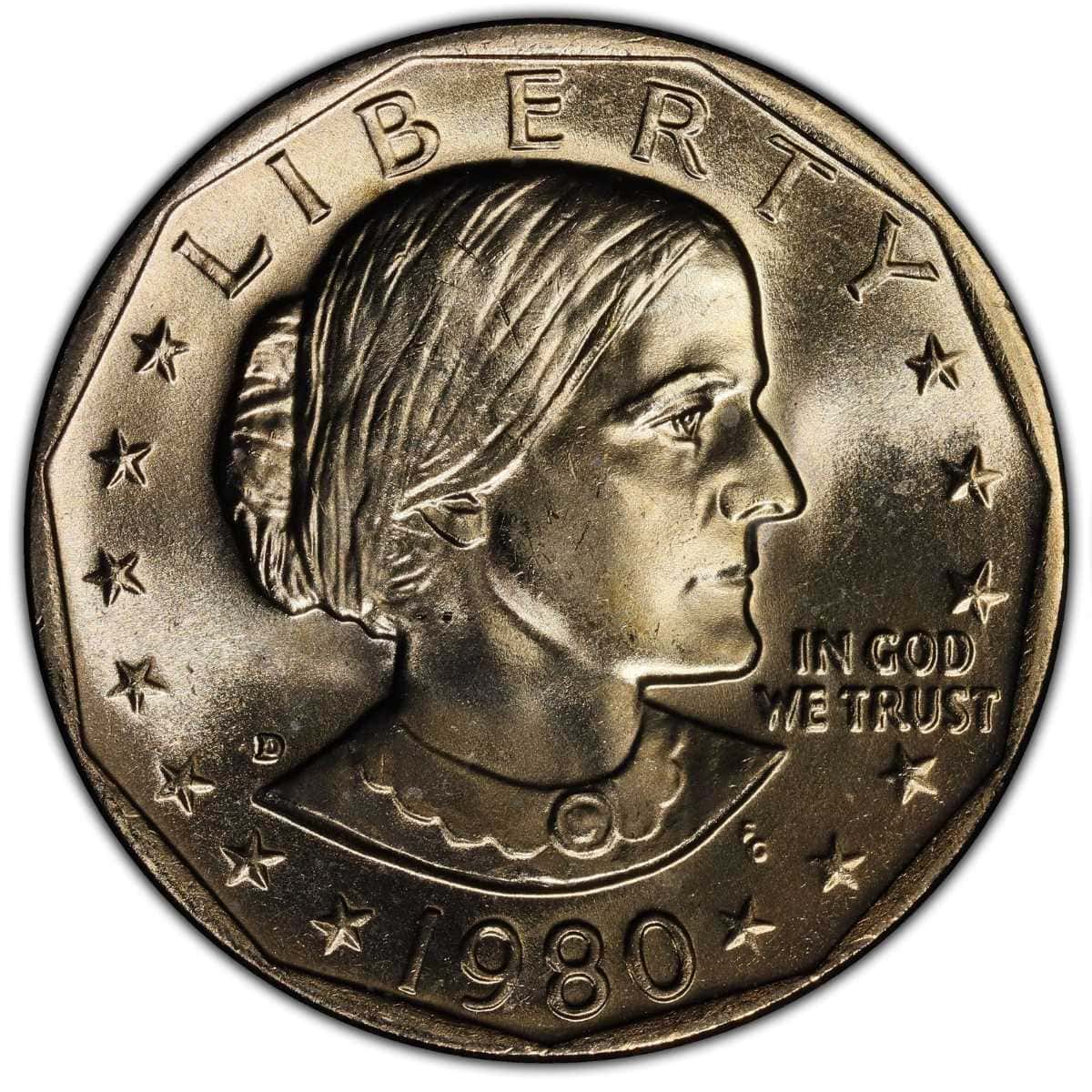
The 1980 Anthony dollar is a widely available coin in almost all grades including uncirculated coins. Only coins graded MS66 and above are difficult to come by.
With all circulated 1980 dollar coins, the value is the same irrespective of the mint mark. These coins start at $1 and the value increases by cents to $1.50 for the highest-grade circulated coins.
The value of uncirculated 1980 dollar coins varies based on mint marks; they are all priced at $5 for MS60, but their value increases through the ranks, reaching MS67, which is valued at $725, $425, and $375 for the S, D, and P mint marks respectively.
| 1980 Dollar Grades and Value Chart | ||
| Mint mark | Circulated
(G4 – AU59) |
Uncirculated
(MS60 – MS67) |
| 1980-P | $1.0 – $1.50 | $5 – $375 |
| 1980-D | $1.0 – $1.50 | $5 – $425 |
| 1980-S | $1.0 – $1.50 | $5 – $725 |
| Proof Coins | CAM | DCAM |
| 1980-S Proof Dollar | $10 – $17.5 | $3 – $50 |
Appearance and Features of the 1980 Susan B. Anthony Dollar
The Susan B. Anthony dollar coins resemble the Washington quarter dollar coins due to the shared color and size.
The Obverse
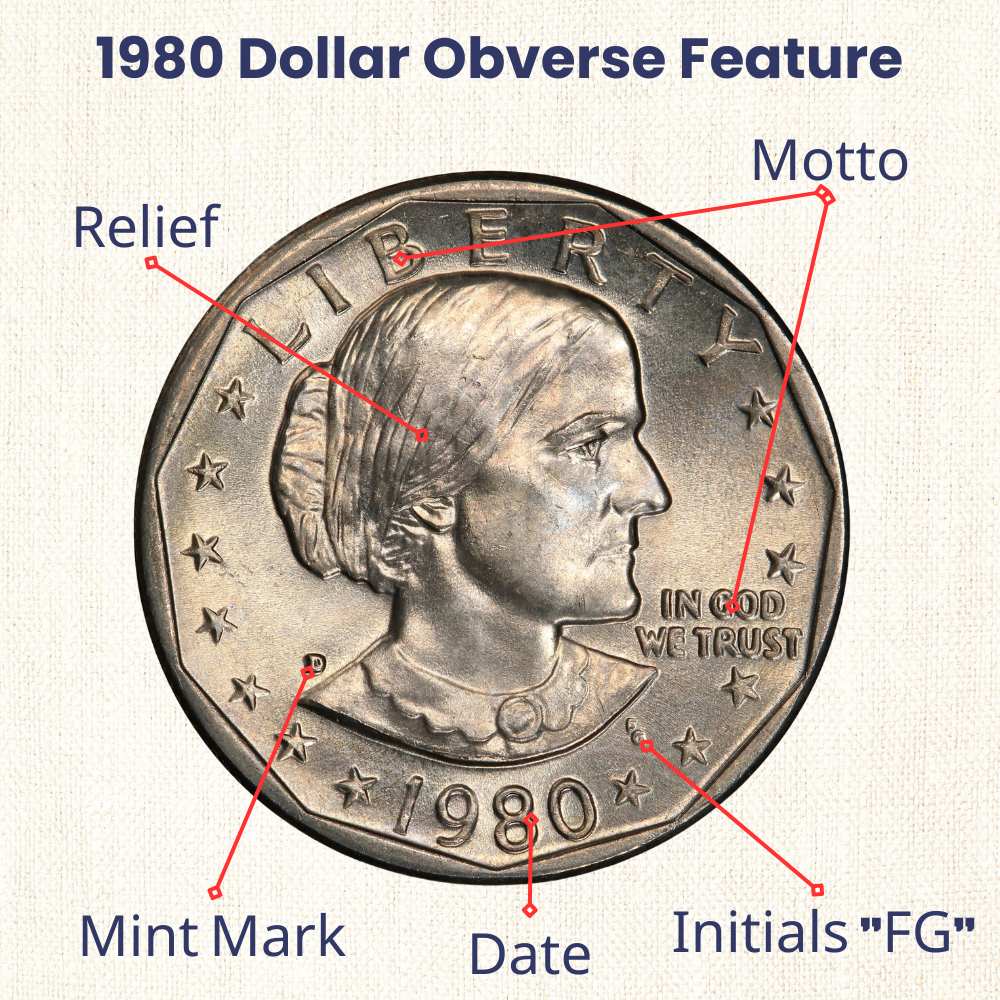
The obverse of the 1980 dollar was designed by then US Mint chief engraver, Frank Gasparro, and the design had the following elements
- Eleven-sided inner border
- Right-facing profile of women’s rights activist, Susan B. Anthony
- The words “LIBERTY” at the top, arching over the image
- The motto “IN GOD WE TRUST” to the left of the image
- 13 stars around the inside border
- Designer’s initials FG under Anthony’s image
- 1980 at the bottom
The Reverse
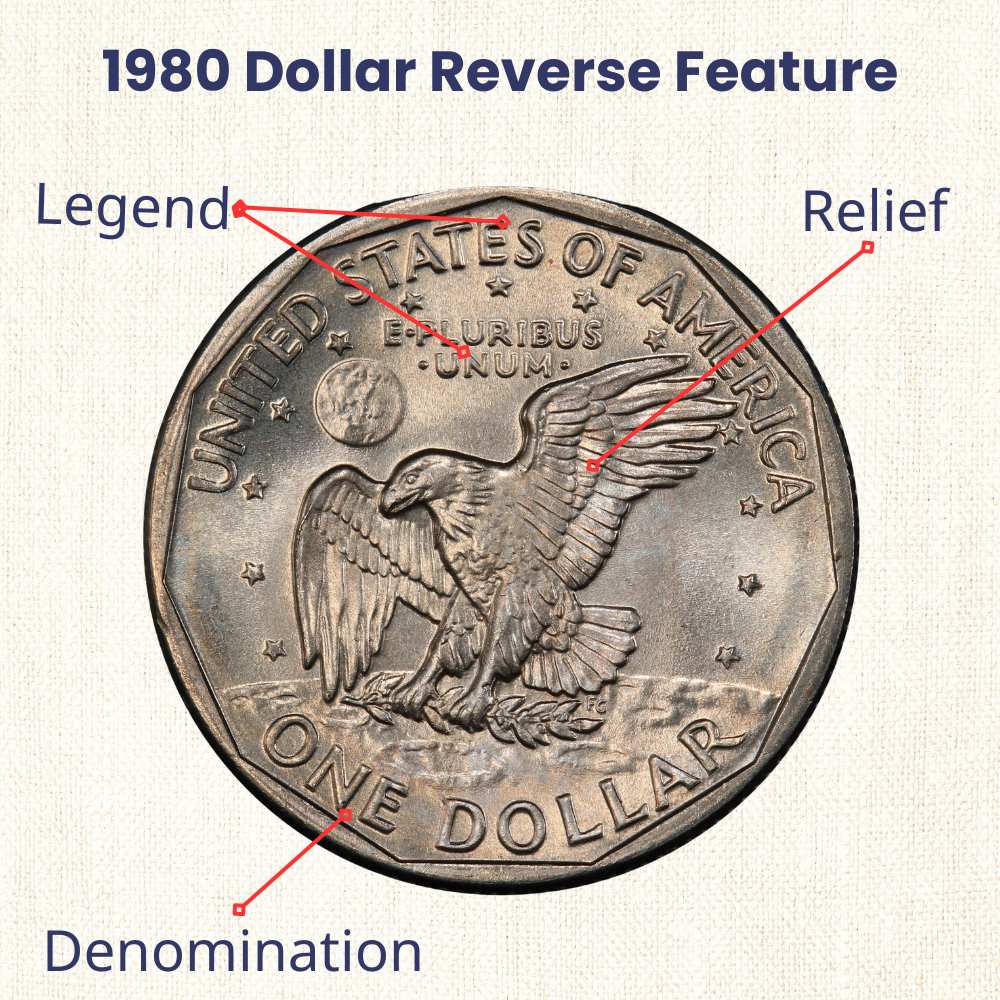
The reverse design was by Frank Gasparro and was the reverse of the previous Eisenhower dollar. It had the following features
- 11-sided inner border
- An eagle landing on the moon with an olive branch in its talons
- The value “ONE DOLLAR” at the bottom
- E PLURIBUS UNUM Above the eagle
- The phrase UNITED STATES OF AMERICA arching along the top edge
- 13 Stars in a circle around the eagle
Other Features
Besides the appearance, here are some other features of the coin.
- 26.5mm diameter
- 8.1g weight
- Reeded edge
- Pure copper core, with copper-nickel clad
- The first US coin featured the image of a real woman
1980-P SBA Dollar Value
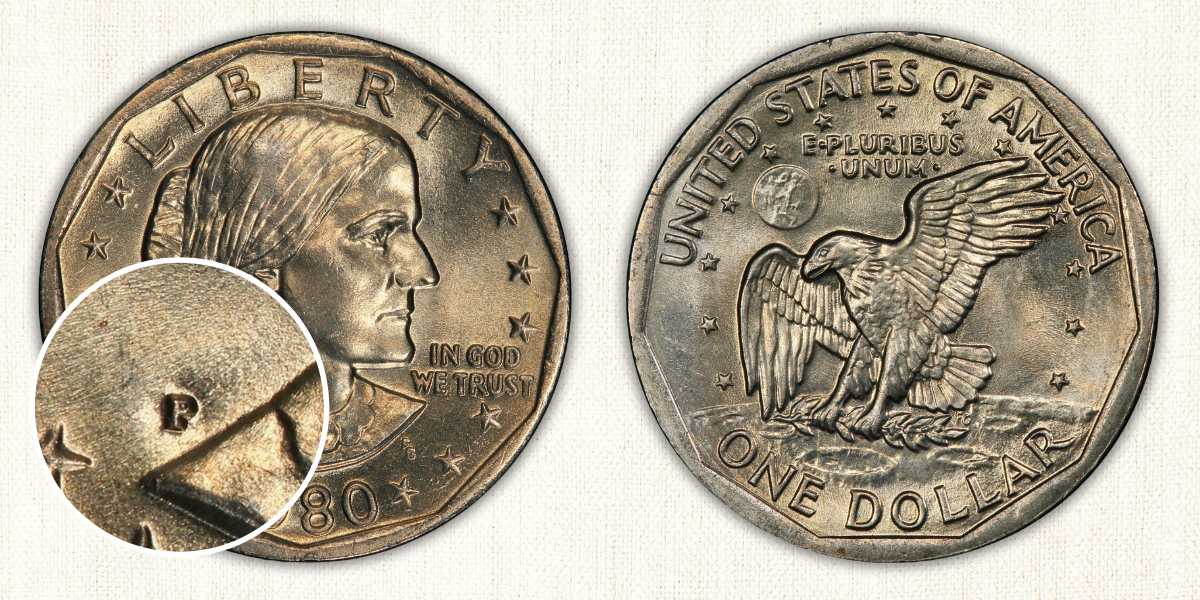
The Philadelphia mint struck 27.6 million 1980 Anthony dollar coins. Due to the age and mintage, the coins have a low numismatic rarity– most grades are common. Although coins above MS66 are scarce, you can still find them with a little digging.
Consequently, all circulated coins cost at least $1, which is the face value of the coin. Dollars with better quality cost a bit more, and an almost-uncirculated (AU58) 1980-P is worth about $1.50.
Naturally, the uncirculated coins have a higher value than the circulated ones, but the difference isn’t too dramatic, as MS60 dollar coins cost $5, MS63 costs $8, and MS66 costs $45.
Superb uncirculated coins above MS66 are relatively less common than the other grades, and this results in a jump in value. An MS67, valued at $150, is significantly more expensive than an MS66. A truly rare MS68 1980-P dollar is worth an impressive $2,150.
But more impressive is the MS68 1980-P Anthony dollar that sold for $4,600 at a Heritage Auction in April 2008.
| 1980-P Dollar Value Chart | |
| Grade | Value |
| Good (G4) | $1.05 |
| About Uncirculated (58) | $1.50 |
| MS 60 | $5 |
| MS 61 | $5 |
| MS 62 | $6 |
| MS 63 | $8 |
| MS 64 | $10 |
| MS 65 | $15 |
| MS 65+ | $20 |
| MS66 | $38 |
| MS 66+ | $45 |
| MS 67 | $150 |
| MS 67+ | $375 |
| MS 68 | $2,150 |
1980-D SBA Dollar Value
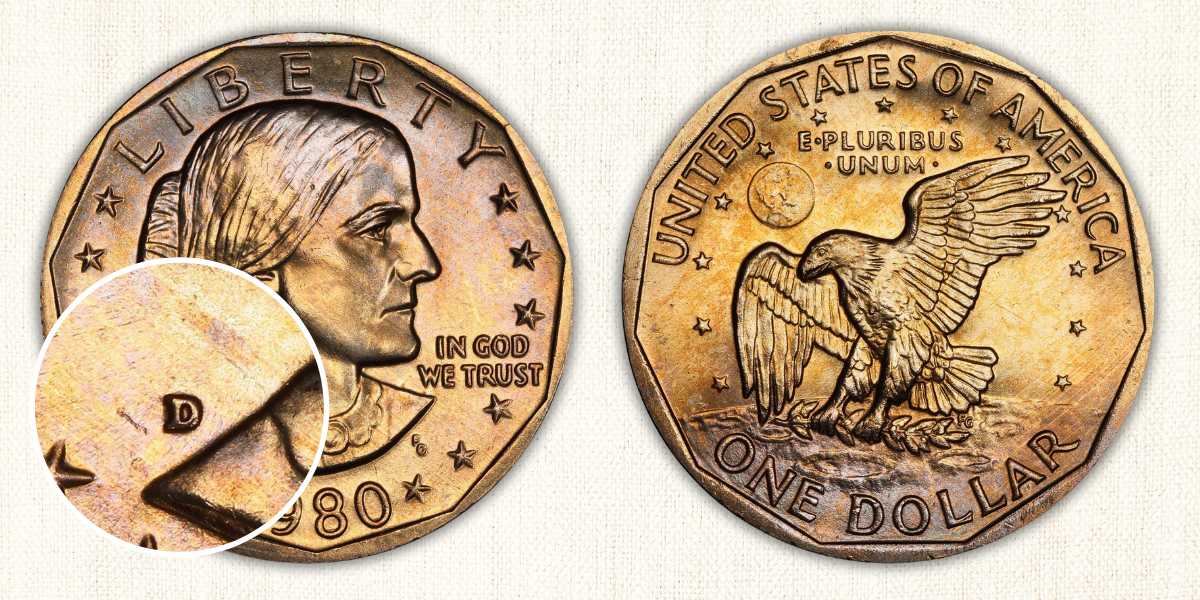
Denver coins are the most common 1980 dollar coins owing to the higher mintage of 41.6 million. So they are readily available at all grades except gem uncirculated grades which are scarce.
Like the Philadelphia dollars, you will find circulated 1980-D dollar coins going for between $1 and $1.5. Similarly, entry-level uncirculated coins go for $5 for MS60 and $8 for MS63, while MS65 is worth $22.
Gem uncirculated grades can fetch as much as $425, and while there have been no 1980-D MS68 dollar coins on record if such a coin ever turns up it will no doubt be worth at least $3,900.
In the meantime, the auction record for a 1980-D Anthony dollar stands at $880.
| 1980-D Dollar Value Chart | |
| Grade | Value |
| Good (G4) | $1 |
| About Uncirculated (50) | $1.5 |
| MS 60 | $5 |
| MS 61 | $5 |
| MS 62 | $6 |
| MS 63 | $8 |
| MS 64 | $14 |
| MS 64+ | $15 |
| MS 65 | $22 |
| MS 65+ | $24 |
| MS66 | $32 |
| MS 66+ | $80 |
| MS 67 | $425 |
1980-S SBA Dollar Value
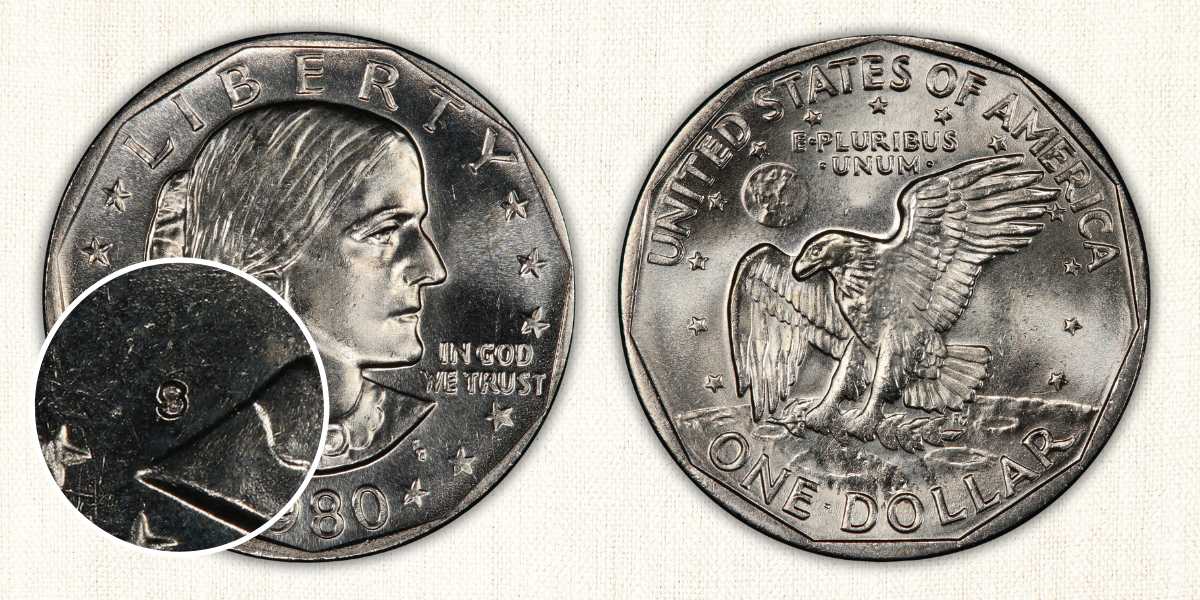
1980-S Anthony dollar coins with a mintage of 17 million, are very similar to the other mintmarks not just in appearance but also in the value.
The circulated grades are worth $1 at least, and $1.5 at most, for about circulated coins. The price similarity is also evident in the lower-grade uncirculated coins which are valued between $5 and $30 for MS60 to MS65.
The higher uncirculated 1980-S dollars are the most expensive, MS66 costs $60, while MS67 costs $725.
Like the Denver dollar, there is also no 1980-S dollar graded above MS67, but if such a coin is ever found, you can expect to pay at least $5,800 for it.
But for now, the most expensive 1980-S Anthony dollar on record is an MS67 worth $9,607. The coin was auctioned by Heritage Auctions in June 2022.
| 1980-S Dollar Value Chart | |
| Grade | Value |
| Good (G4) | $1 |
| About Uncirculated (58) | $1.5 |
| MS 60 | $5 |
| MS 61 | $5 |
| MS 62 | $6 |
| MS 63 | $10 |
| MS 64 | $16 |
| MS 64+ | $22 |
| MS 65 | $30 |
| MS 65+ | $36 |
| MS66 | $60 |
| MS 66+ | $90 |
| MS 67 | $725 |
| MS 67+ | $1,600 |
1980-Proof SBA Dollar Value
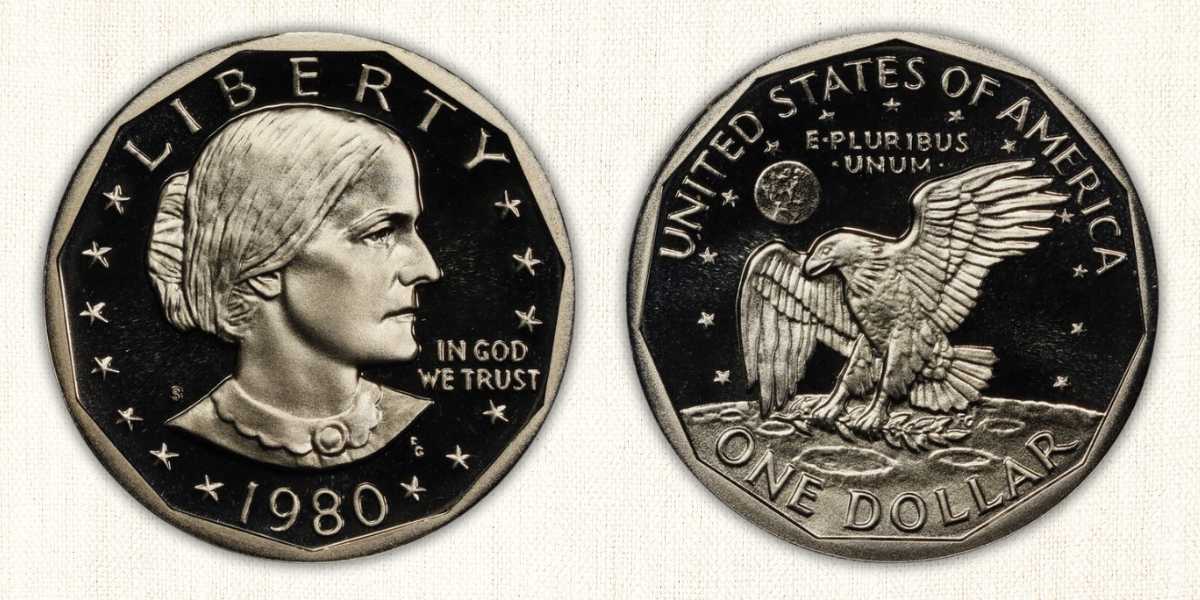
1980 dollar Proof coins have an S Mintmark, as all 3.5 million of them were made in San Francisco.
The coins were so well-struck that the majority of them are designated as a deep cameo (DCAM) which is the highest designation for proof coins that display deep even frosting on the reverse and obverse.
The 1980 proofs are less expensive than the 1980-S uncirculated business strikes. A PR60 goes for $3 and you can get a perfect PR70 for $50. What few coins that aren’t DCAM, are Cameo (CAM). These go for $10 to $18.
The current record for the most expensive 1980 dollar proof coin is $748 for a Deep cameo PR70, sold by Heritage Auctions in April 2007.
| 1980-Proof Dollar: Grade and Value Chart | ||
| Grade | CAM | DCAM |
| PR 60 | – | $3 |
| PR 61 | – | $3 |
| PR 62 | – | $4 |
| PR 63 | – | $5 |
| PR 64 | – | $5 |
| PR 65 | – | $6 |
| PR 66 | $10 | $7 |
| PR 66+ | $10 | $7 |
| PR 67 | $12.5 | $8 |
| PR 68 | $15 | $12 |
| PR 69 | $17.5 | $20 |
| PR 70 | – | $50 |
1980 SBA Dollar: Error Coins
You can find error coins in roughly equal proportions for all three mintmark varieties of the 1980 dollar. Some of the most common errors include planchet errors, die errors, and strike errors.
1980-P Susan B. Anthony Dollar Obverse Struck Through Error

Here is a 1980-P dollar coin with a strike through error on the left part of the obverse.
Strike through errors happen when something gets between the planchet and the die before the coin gets struck. The object will usually leave an impression on the coin. But if the coin was struck through grease, the only evidence will be the partial or faint design elements, or a smooth area where the design is missing.
This 1980-P coin was likely struck through grease, as there is no distinct mark on it, but the design on the left appears faint. The coin is circulated, but NGC certified, it goes for $239.
1980-P Susan B. Anthony Dollar Reverse Struck Through Grease Error
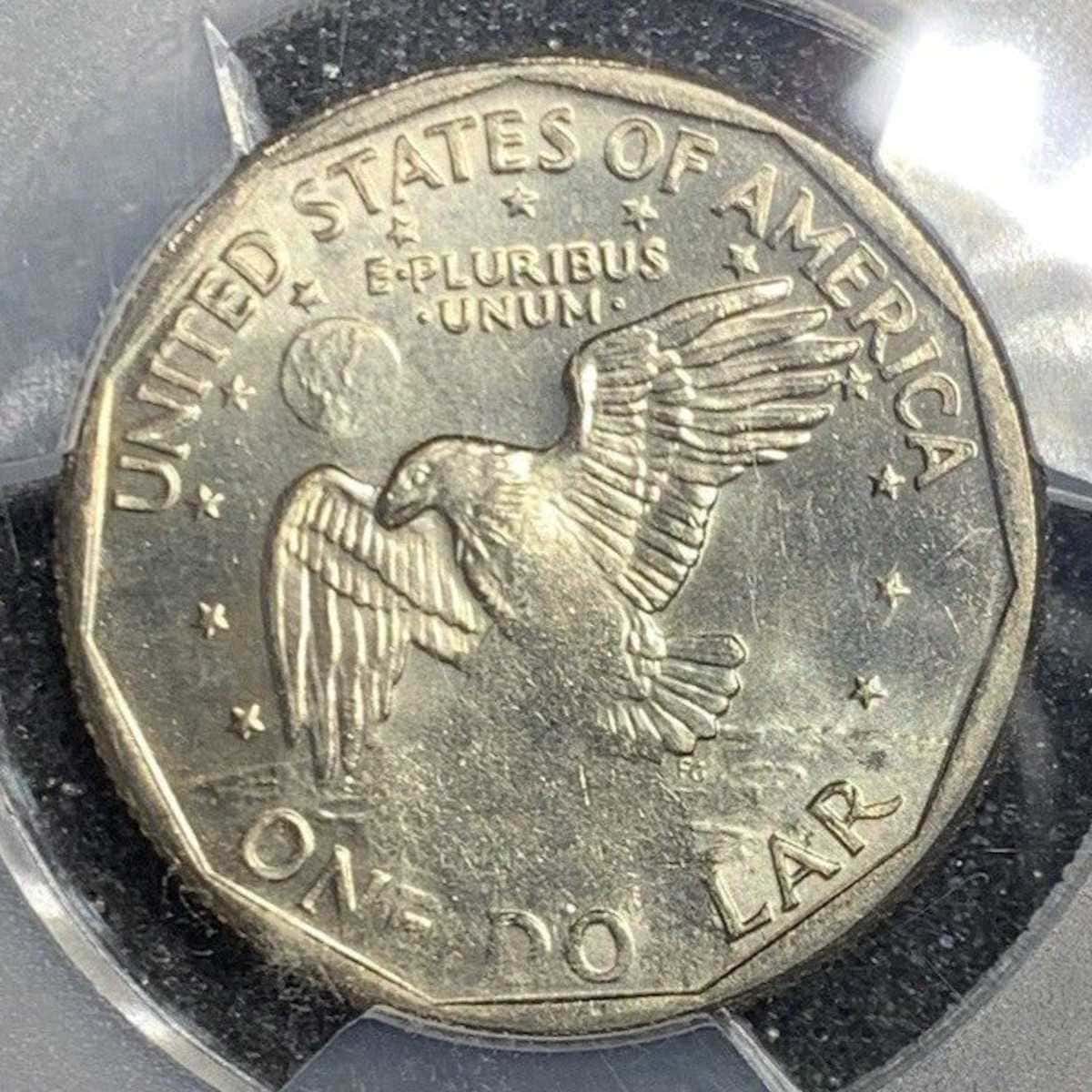
This is a 1980-S Anthony dollar coin with a struck through grease error on the reverse side, thus making the reverse design appear less detailed.
The error is most obvious at the bottom of the coin where it completely obscures the legs of the eagle, the olive branch, and the moon, as well as the coin face value of “ONE Dollar.” The coin which is PCGS certified as MS66 is valued at $990
1980-P Susan B. Anthony Dollar Struck on Wrong Planchet
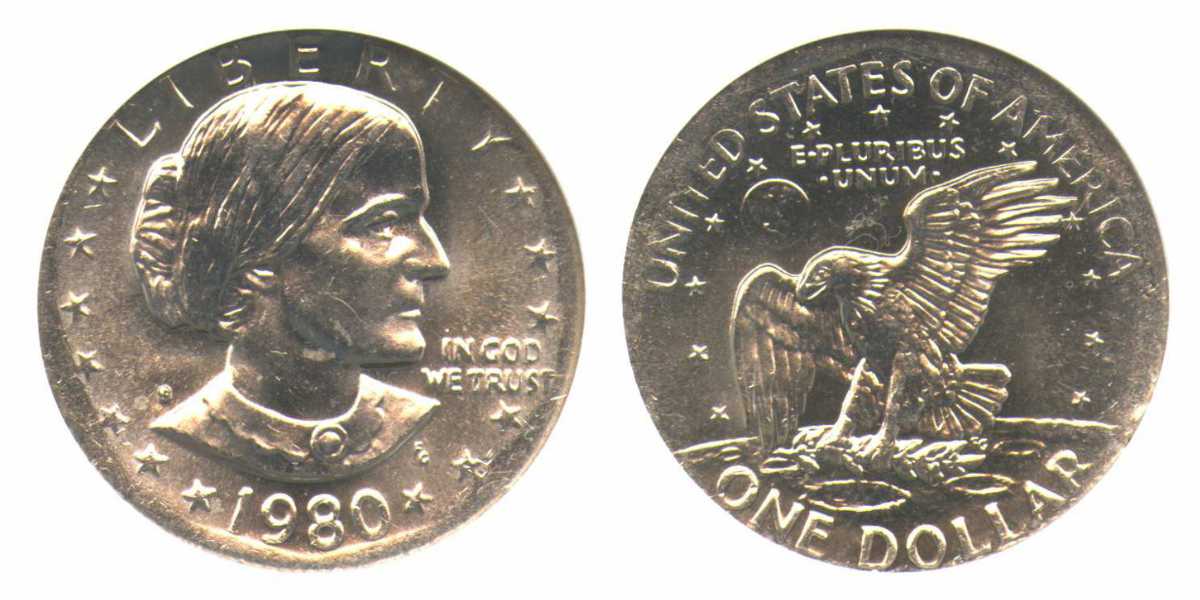
This 1980-D dollar has been struck on a 25-cent Washington planchet.
Since a quarter planchet is smaller, the entire dollar design does not fit into the quarter planchet and some aspects of the design don’t get shown. In this case, the coin was struck on center, so it’s just the 11-sided inside border that isn’t captured on both the obverse and reverse sides.
This error is easily explained; a wrong planchet found its way into the dies. But despite its smaller size, the coin is worth $997. It also has an ANACS grading of MS64.
1980-P Susan B. Anthony Dollar Missing Clad Layer
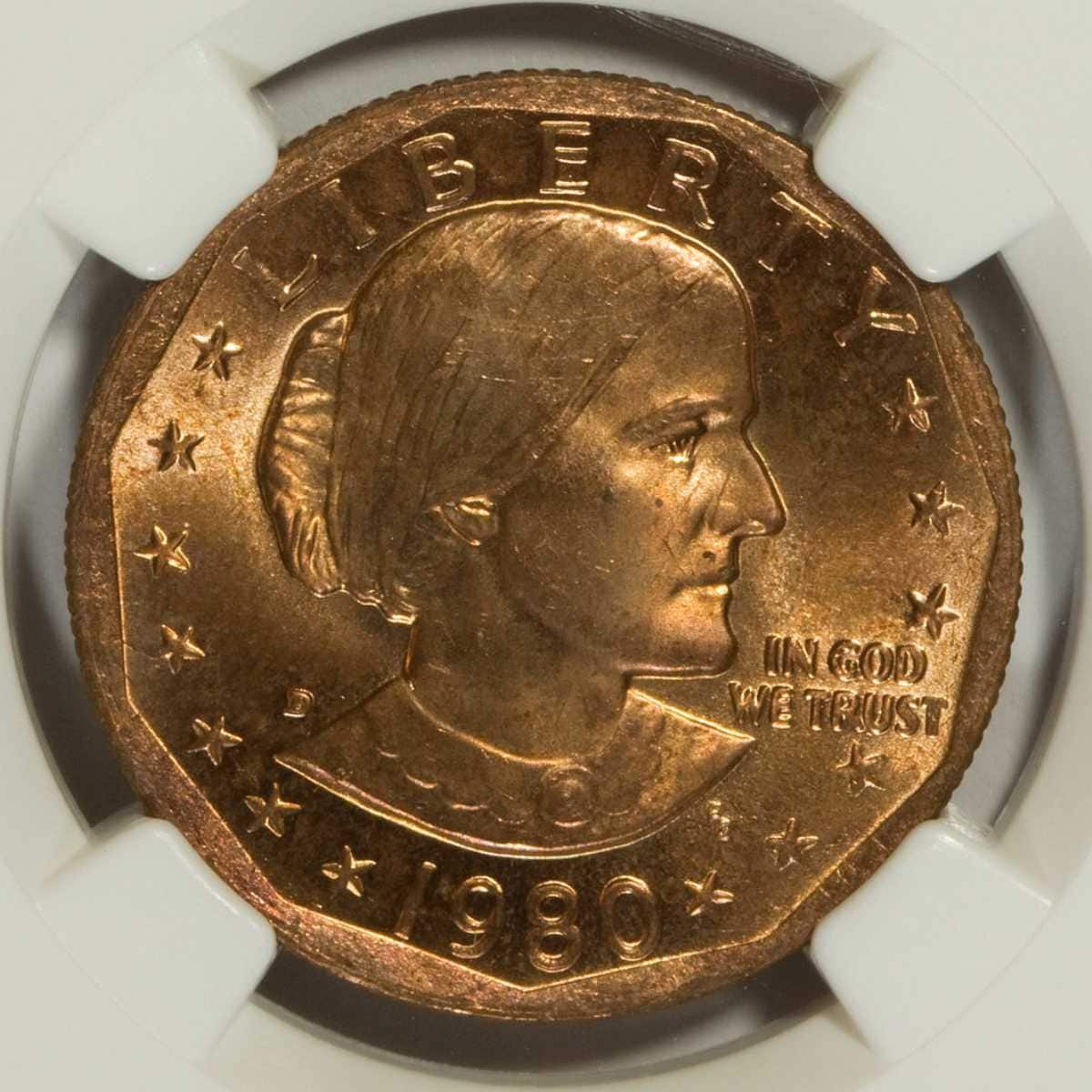
The 1980 Anthony dollar coins sometimes have a missing Clad Layer, as seen in this copper-colored 1980-S coin.
A missing Clad Layer is a mint error whereby the copper-nickel layer on the obverse or reverse (or both in extreme cases) detaches from the copper core, as a result, the coin is about 15% lighter than normal.
Coins with a missing clad layer on the reverse are generally less expensive than those with missing clad on the obverse, as is the case with this MS64 1980-S dollar coin which costs $350.
The coin weighs 6g rather than the correct 8.1g.
1980-P SBA Dollar Defective Obverse Clad Layer Error

Unlike the previous coin with a missing clad, this 1980-D has a defective obverse clad.
This type of error is caused by improper blending of the copper-nickel alloy that makes up the clad layers.
There’s a prominent streak of copper running diagonally across the obverse from 1 O’clock to 7 O’clock. The error gives the coin a striking appearance which drastically increases the value, as this MS64 1980-D dollar is priced at $750.
1980-P SBA Dollar Clipped Planchet Error
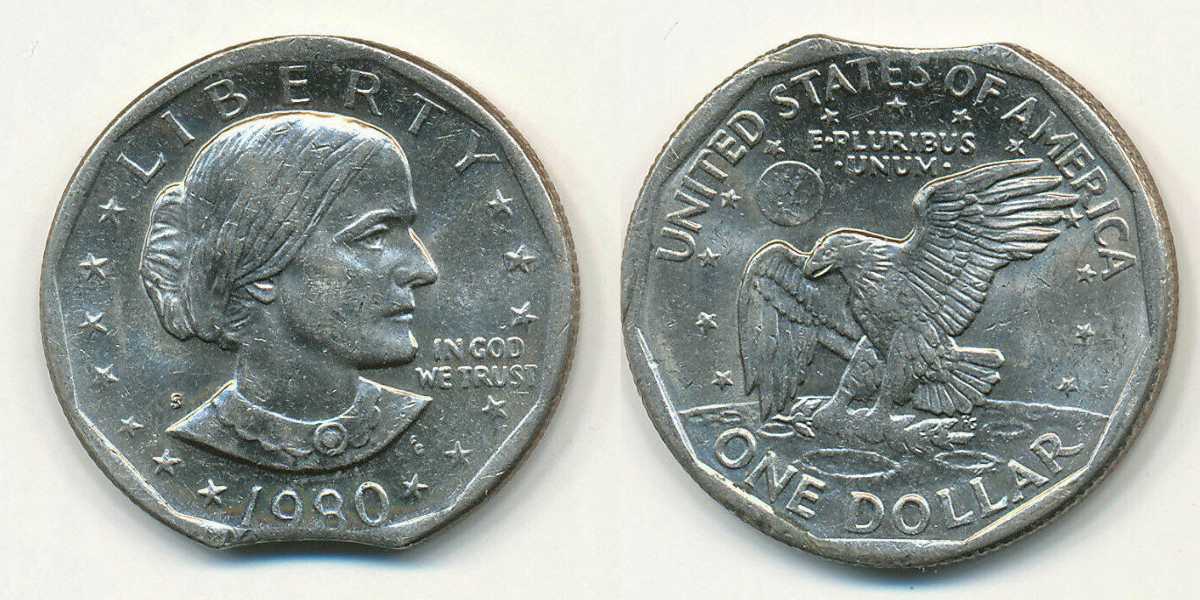
This ungraded 1980-S dollar coin has a small straight clip on the bottom edge.
A straight clip planchet error like this arises when the punch of the blanking die overlaps the straight edge of the metal strip. The resulting planchet will have a straight clip at the spot of the overlap.
On the reverse, the clip is at the top edge and only affects the last letters in the word “STATES” while on the obverse, the clip grazes the bottom of the dater. The coin appears to have been minimally circulated, and it’s priced at $109.
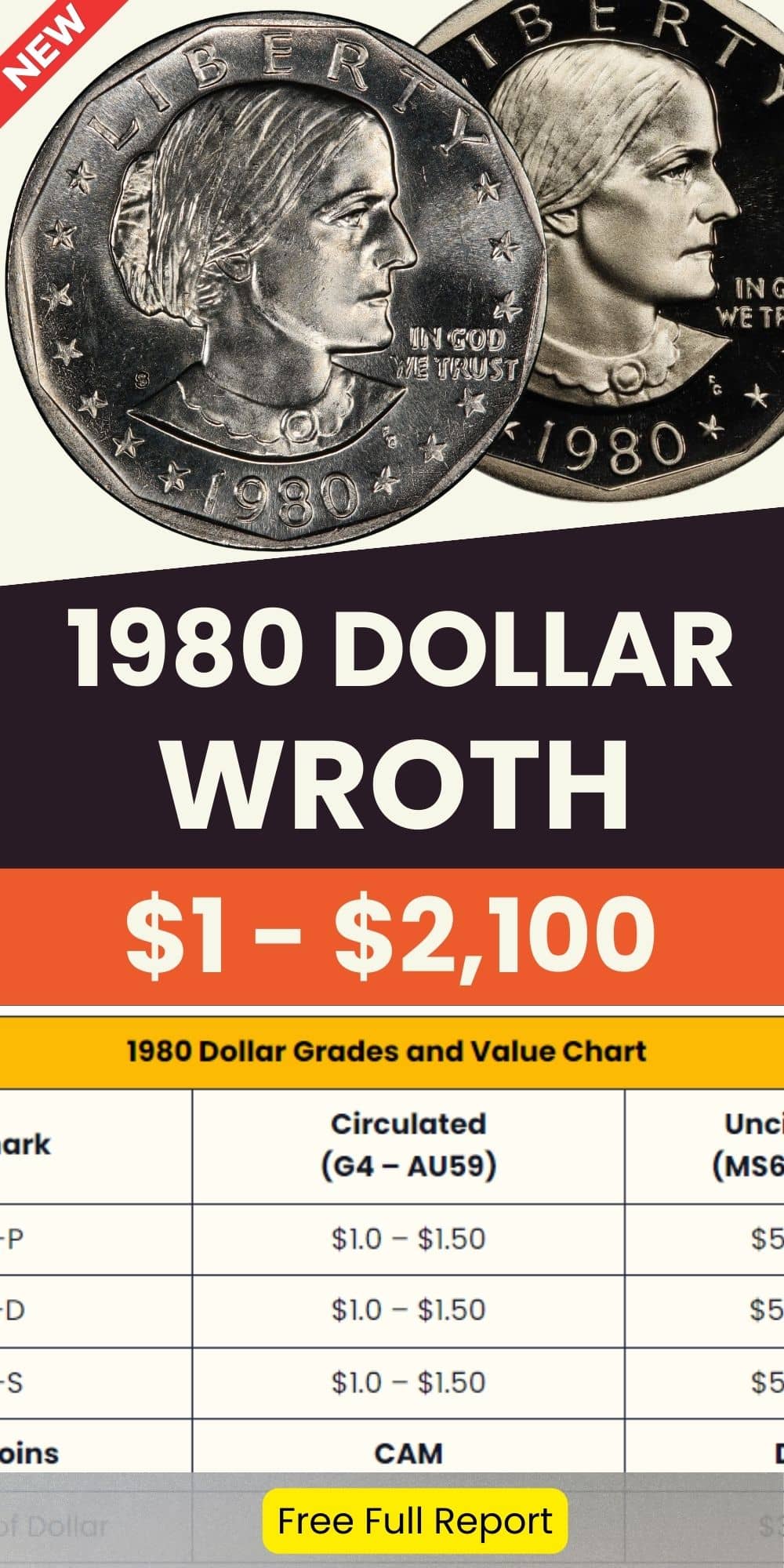
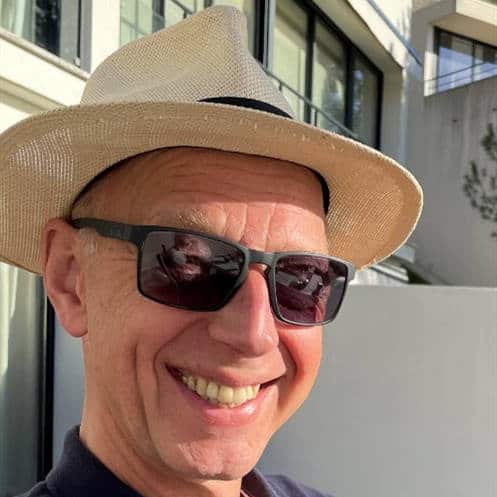
Jenson is a professional numismatist, a dedicated coin collector, a graduate of the College of Business at Oregon State, a life member of the American Numismatic Association (ANA), and an overall coin nerd. He is the founder of Coin Value List.
